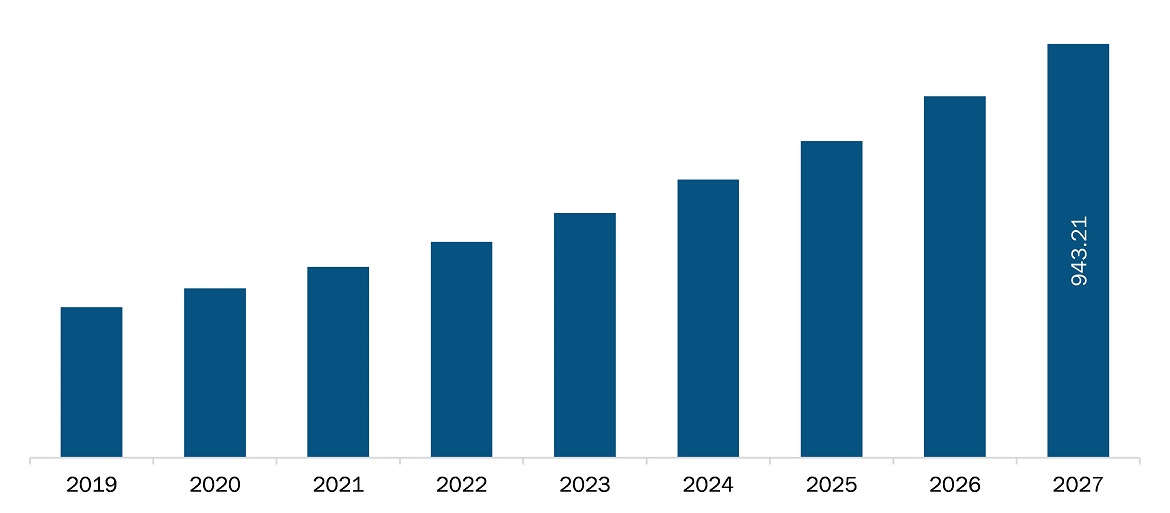The North America patient registry software market is expected to grow from US$ 385.9 million in 2020 to US$ 943.2 million by 2027; it is estimated to grow at a CAGR of 13.6% from 2020 to 2027.
The ongoing revolution of digital infrastructure in healthcare across the region is spurred by regulations enforced and investments provided by the government authorities. In addition, rising demand for data collection for analysis and increasing pressure on healthcare providers to reduce the cost of treatments and procedures are leading to the progress of healthcare digitalization in countries worldwide. Moreover, in 2017, the former president of the US (Barack Obama) introduced the Health Information Technology for Economic and Clinical Health (HITECH) Act of 2009. This legislation offered financial incentives to healthcare providers to incorporate IT solutions in various processes, whereas enforced financial penalties on those who didn’t. This initiative led to massive increase in the adoption of electronic health records (EHRs) and patient registries for the evaluation of specified outcomes for patients who are suffering from a particular disease or condition. Therefore, the surging incorporation of digital tools in the healthcare structure drives the growth of the patient registry software market.
The effectiveness of patient registry software to gather and analyze patient data is expected to have constructive impact on the adoption of patient registry software in the region. Moreover, majority of the market players, research centers, and academic institutions are focusing on the adoption of patient registries with an aim to streamline the patient data collection and analysis. In February 2021, the Leukemia & Lymphoma Society (LLS) announced strategic partnership with Ciitizen, a significant player in digital health solution in order to study on the relation between coronavirus and vaccination amongst blood cancer patients. The institution launched LLS National Patient Registry in order to gather data of blood cancer patients for the study. Further, in April 2020, the American Heart Association announced development of a novel patient registry to collect data, which will help the researchers to understand co-relation between coronavirus, cardiovascular diseases, and related treatment protocols. Moreover, in July 2020, Oracle and the National Institutes of Health (NIH) established a patient data registry to gather COVID-19 patients’ data. The partnership has termed this platform as COVID-19 Prevention Network (CoVPN). In addition, in April 2020, IQVIA Inc. announced the launch of a broad and open patient registry platform for advanced understanding and research of covid-19. These developments are likely to have constructive impact on the North America patient registry software market during and post-pandemic period.
With the new features and technologies, vendors can attract new customers and expand their footprints in emerging markets. This factor is likely to drive the patient registry software market. The North America patient registry software market is expected to grow at a good CAGR during the forecast period.

- This FREE sample will include data analysis, ranging from market trends to estimates and forecasts.
North America Patient Registry Software Market Segmentation
By Software
- Standalone
- Integrated
By Database
- Public
- Commercial
By Type of Registry
- Product Registry
- Disease Registry
- Cardiovascular Disease Registry
- Others
- Health Service Registry
By Mode of Delivery
- On-Premises
- Cloud-Based
By Pricing Model
- Ownership
- Subscription
By Country
-
North America
- US
- Canada
- Mexico
Companies Mentioned
- IQVIA Inc.
- FIGmd Inc.
- Medstreaming
- Open Text Corporation
- Evado Clinical
- LUMEDX
- CEDARON
- IBM Corporation
- Mckesson Corporation
- Dacima Software Inc
North America Patient Registry Software Report Scope
| Report Attribute | Details |
|---|---|
| Market size in 2020 | US$ 385.9 Million |
| Market Size by 2027 | US$ 943.2 Million |
| CAGR (2020 - 2027) | 13.6% |
| Historical Data | 2018-2019 |
| Forecast period | 2021-2027 |
| Segments Covered |
By Software
|
| Regions and Countries Covered |
North America
|
| Market leaders and key company profiles |
|
- Historical Analysis (2 Years), Base Year, Forecast (7 Years) with CAGR
- PEST and SWOT Analysis
- Market Size Value / Volume - Regional, Country
- Industry and Competitive Landscape
- Excel Dataset
Recent Reports
Testimonials
Reason to Buy
- Informed Decision-Making
- Understanding Market Dynamics
- Competitive Analysis
- Identifying Emerging Markets
- Customer Insights
- Market Forecasts
- Risk Mitigation
- Boosting Operational Efficiency
- Strategic Planning
- Investment Justification
- Tracking Industry Innovations
- Aligning with Regulatory Trends





















 Get Free Sample For
Get Free Sample For